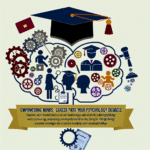
Introduction
Navigating the world of learning disabilities can seem overwhelming for parents. The moment of diagnosis is often a whirlwind of emotions—fear, confusion, and determination to help your child succeed. However, this journey is far from hopeless. In fact, it can be a pathway to empowerment, resilience, and ultimately, success. In this article, "From Diagnosis to Success: A Parent’s Guide to Managing Learning Disabilities," we will explore practical strategies, valuable insights, and real-world case studies that illuminate the route from diagnosis to thriving.
Understanding Learning Disabilities
What Are Learning Disabilities?
Learning disabilities (LD) are neurological disorders that affect the brain’s ability to receive, process, and respond to information. They can impact skills such as reading, writing, math, and even social interaction. It’s essential to understand that a learning disability does not reflect a person’s intelligence; many individuals with LD excel in creative or problem-solving capacities.
Types of Learning Disabilities
- Dyslexia: Difficulty with reading due to problems identifying speech sounds and learning how they relate to letters and words.
- Dyscalculia: Challenges with numbers and math-related concepts.
- Dysgraphia: Difficulty with writing, which can manifest as poor handwriting or struggles with expressing thoughts on paper.
- Auditory and Visual Processing Disorders: Issues in hearing or interpreting sounds and visual information.
Common Signs and Symptoms
Recognizing the symptoms early can be crucial for effective management. Here are a few signs to watch for:
| Signs | Examples |
|---|---|
| Reading Difficulties | Trouble decoding words or following a text. |
| Math Challenges | Difficulty with basic arithmetic or number relationships. |
| Writing Issues | Poor spelling, grammar, and written expression. |
| Attention Concerns | Difficulty focusing, which may not be solely ADHD. |
Identifying these symptoms is the first step to success for both parents and children.
The Diagnosis Journey
Seeking an Evaluation
If you suspect your child may have a learning disability, initiating an evaluation is crucial. Consult with a pediatrician or school psychologist who can direct you to educational assessments.
Understanding the Evaluation Process
The evaluation typically involves various methods, including:
- Standardized Tests: To gauge your child’s academic abilities against age norms.
- Behavioral Assessments: To identify any behavioral issues that may contribute to learning difficulties.
- Parent and Teacher Reports: Collecting observational data to build a comprehensive view.
Case Study: Sarah’s Journey
Sarah, an 8-year-old diagnosed with dyslexia, struggled with reading aloud. After extensive evaluation, her parents discovered she was reading at a second-grade level despite being in third grade. Armed with this information, they were empowered to seek targeted interventions.
Analysis
In Sarah’s case, obtaining a clear diagnosis was transformative. It allowed her family to focus on specific strategies that catered to her unique learning style.
Creating an Actionable Plan
Building an Individualized Education Plan (IEP)
Once a diagnosis is confirmed, collaborating with school staff to create an IEP is essential. An IEP is tailored to a child’s individual needs and outlines specific educational goals and accommodations.
Effective Strategies for Home and School
1. Reading Support
- Utilize phonics-based reading programs.
- Incorporate audiobooks to enhance comprehension.
2. Math Training
- Use visual aids like manipulatives or number lines.
- Incorporate games that reinforce math concepts.
3. Writing Aids
- Encourage typing over handwriting as a starting point.
- Use graphic organizers to help structure writing tasks.
Case Study: Mark’s Math Mastery
Mark, diagnosed with dyscalculia, found math particularly challenging. After creating an IEP that included the use of visual aids and hands-on activities, his enthusiasm for math increased dramatically. His engagement allowed for a deeper grasp of concepts he initially struggled with.
Analysis
Mark’s experience highlights the need for tailored activities that suit his learning style, enabling him to gain confidence and mastery in math.
Engaging with Emotional Support
The Importance of Emotional Well-being
Learning disabilities can lead not only to academic struggles but also emotional challenges like anxiety and low self-esteem. Supporting your child emotionally is just as important as academic intervention.
Building Resilience
Encourage resilience with these strategies:
- Praise Efforts Over Results: Foster a growth mindset by recognizing hard work, not just achievements.
- Open Dialogue: Create a safe space for your child to express their feelings and frustrations.
- Professional Help: Don’t hesitate to reach out to a counselor if emotional support is needed.
Case Study: Emily’s Emotional Growth
Emily, who faced severe anxiety related to her learning disability, began therapy with a specialized counselor. Over time, she learned coping strategies that significantly reduced her anxiety and improved her self-image.
Analysis
Emily’s journey emphasizes the importance of emotional health in conjunction with learning interventions, illustrating how both aspects contribute to overall success.
Building Advocacy Skills
Empowering Your Child
Teaching your child to advocate for themselves is invaluable. Encourage them to:
- Speak Up: Let them express their needs or difficulties.
- Set Goals: Help them set achievable academic and personal goals.
- Seek Support: Encourage them to ask teachers for help when needed.
Networking with Other Parents
Connecting with other parents can provide emotional support and shared insights into effective strategies. Online forums, local support groups, and social media platforms can serve as excellent resources.
Case Study: David’s Self-Advocacy
David, who struggled with his learning disability, learned to articulate his needs in class. Initially hesitant, he eventually made a presentation to his classmates explaining his challenges. This fostered peer understanding and friendship.
Analysis
David’s ability to advocate for himself not only helped him academically but also socially, illustrating the importance of self-awareness in navigating learning differences.
Resources at Your Disposal
Recommended Books and Materials
| Title | Author | Focus Area |
|---|---|---|
| "Overcoming Dyslexia" | Sally Shaywitz | Dyslexia |
| "The Dyscalculia Toolkit" | Ronit Bird | Dyscalculia |
| "Writing with Ease" | Susan Wise Bauer | Writing Skills |
Online Platforms
- LearnDifferently: A resource for various learning styles and disabilities.
- LD Online: Offers vast information regarding learning disabilities and strategies for parents.
Professional Organizations
- International Dyslexia Association: Supports research and education about dyslexia.
- Learning Disabilities Association of America: Provides resources for parents and educators.
Conclusion
Navigating the journey from diagnosis to success with a learning disability can be a formidable challenge, but it is essential to remember that you are not alone. As a parent, your proactive involvement is vital in transforming your child’s educational experience.
By implementing tailored strategies, fostering emotional well-being, and empowering self-advocacy, you will not only help your child thrive academically but also cultivate lifelong resilience.
The road is long, but every step towards understanding your child’s unique learning journey leads to success.
FAQs
1. What is the first step after a learning disability diagnosis?
- The first step is to consult with your child’s school for an evaluation and create an IEP or 504 Plan tailored to your child’s needs.
2. How can I support my child emotionally during this journey?
- Maintain open communication, validate their feelings, and consider professional counseling if necessary.
3. Are there specific resources for parents to learn more?
- Yes, books like "Overcoming Dyslexia" and websites like LD Online offer valuable insights and strategies.
4. What are some effective advocacy strategies for children?
- Teach them to express their needs, set achievable goals, and seek assistance from teachers.
5. How can I monitor my child’s progress effectively?
- Regularly review their IEP goals with teachers, hold meetings to discuss academic performance, and encourage your child to reflect on their learning.
By embracing this journey with courage and knowledge, you will be well-equipped to support your child in achieving their unique version of success.

















